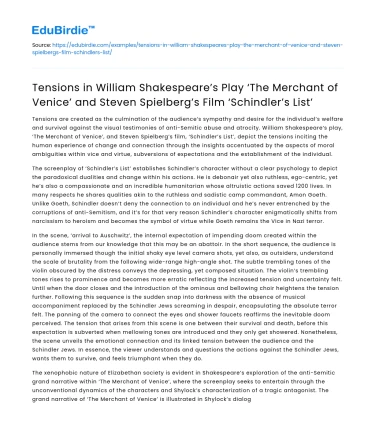Tensions are created as the culmination of the audience’s sympathy and desire for the individual’s welfare and survival against the visual testimonies of anti-Semitic abuse and atrocity. William Shakespeare’s play, ‘The Merchant of Venice’, and Steven Spielberg’s film, ‘Schindler’s List’, depict the tensions inciting the human experience of change and connection through the insights accentuated by the aspects of moral ambiguities within vice and virtue, subversions of expectations and the establishment of the individual.
The screenplay of ‘Schindler’s List’ establishes Schindler’s character without a clear psychology to depict the paradoxical dualities and change within his actions. He is debonair yet also ruthless, ego-centric, yet he’s also a compassionate and an incredible humanitarian whose altruistic actions saved 1200 lives. In many respects he shares qualities akin to the ruthless and sadistic camp commandant, Amon Goeth. Unlike Goeth, Schindler doesn’t deny the connection to an individual and he’s never entrenched by the corruptions of anti-Semitism, and it’s for that very reason Schindler’s character enigmatically shifts from narcissism to heroism and becomes the symbol of virtue while Goeth remains the Vice in Nazi terror.
Save your time!
We can take care of your essay
- Proper editing and formatting
- Free revision, title page, and bibliography
- Flexible prices and money-back guarantee
In the scene, ‘arrival to Auschwitz’, the internal expectation of impending doom created within the audience stems from our knowledge that this may be an abattoir. In the short sequence, the audience is personally immersed though the initial shaky eye level camera shots, yet also, as outsiders, understand the scale of brutality from the following wide-range high-angle shot. The subtle trembling tones of the violin obscured by the distress conveys the depressing, yet composed situation. The violin’s trembling tones rises to prominence and becomes more erratic reflecting the increased tension and uncertainty felt. Until when the door closes and the introduction of the ominous and bellowing choir heightens the tension further. Following this sequence is the sudden snap into darkness with the absence of musical accompaniment replaced by the Schindler Jews screaming in despair, encapsulating the absolute terror felt. The panning of the camera to connect the eyes and shower faucets reaffirms the inevitable doom perceived. The tension that arises from this scene is one between their survival and death, before this expectation is subverted when mellowing tones are introduced and they only get showered. Nonetheless, the scene unveils the emotional connection and its linked tension between the audience and the Schindler Jews. In essence, the viewer understands and questions the actions against the Schindler Jews, wants them to survive, and feels triumphant when they do.
The xenophobic nature of Elizabethan society is evident in Shakespeare’s exploration of the anti-Semitic grand narrative within ‘The Merchant of Venice’, where the screenplay seeks to entertain through the unconventional dynamics of the characters and Shylock’s characterization of a tragic antagonist. The grand narrative of ‘The Merchant of Venice’ is illustrated in Shylock’s dialogue within his release of pent-up frustration deriving from the tensions against the anti-Semitic semantics, evident in the expose of “You call me misbeliever, cutthroat dog, and spent upon my Jewish gaberdine”. Additionally, “Signor Antonio, many a time and oft in the Rialto you have rated me about my money and my usances”, alludes us to the regularity of anti-Semitic abuse Shylock has to endure. Through contemplating the remarks against Shylock, we come to recognize that the nature of the abuse is strictly against his Jewish qualities rather than against his individual. We the as the audience sympathize with Shylock through the realization of moral ambiguities, inconsistencies and the corruption of anti-Semitism within all the characters and society that gratuitously tramples over him.
The dramatic tension created in the trial scene is the outcome of the audience’s emotional connection created with Shylock through an understanding of the regular abuse he endures. We consider Shylock’s welfare, unlike the uncertainty and relief felt when expectations are subverted in ‘Schindler's List’. We yearn for something other than the expected. Despite being conscious of his circumstances, because of our knowledge and experience, we expect Shylock to be the sole sufferer, as he is the villain. Consequently, when he loses and only keeps half his estate through the conversion to Christianity, he catalyzes a further internal tension against the injustice of prejudice and the scrutiny against perpetrators. Unlike ‘Schindler’s List’, there’s no Schindler, there’s no force frustrating anti-Semitism, there’s no individual connection, there’s no change. But unlike the characters within ‘The Merchant of Venice’, we make the change and connection.
Through understanding the features of context and moral ambiguities, as well as the establishment of the individual and subversions of expectations within both texts, we are able to better perceive the tensions insinuated between individual’s well-being and anti-Semitic visual testimonies of abuse and atrocities. The effects of which subsequently prompt the human experiences of change and connection.






 Stuck on your essay?
Stuck on your essay?

